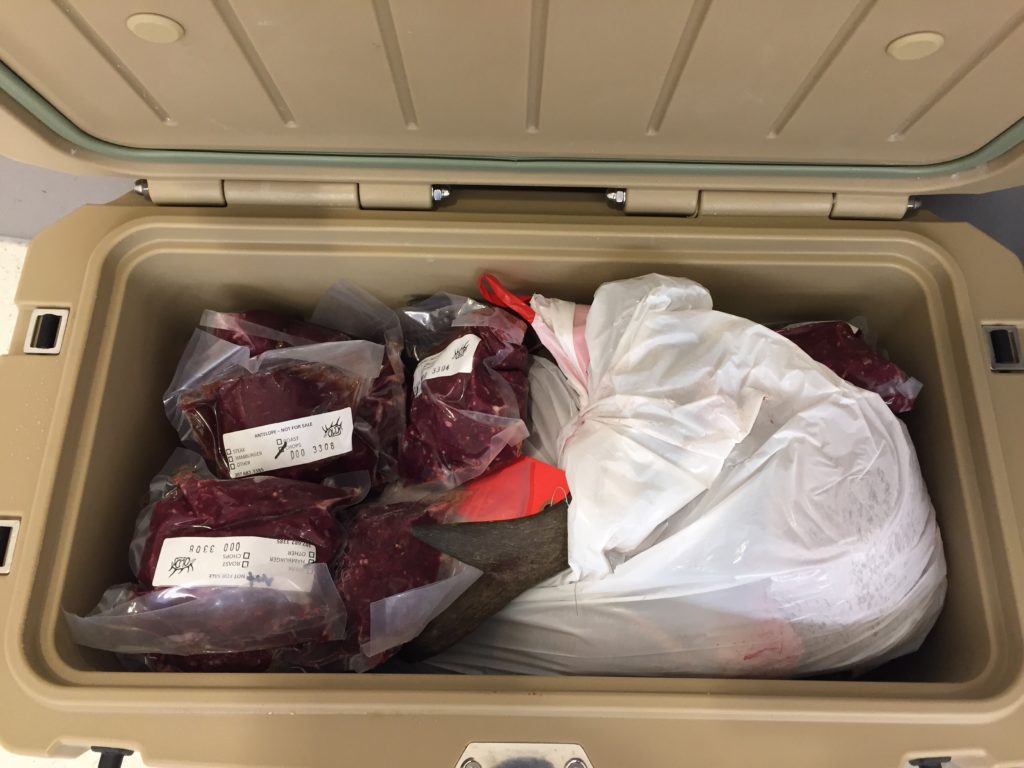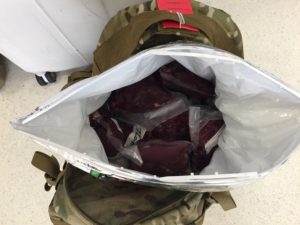Congratulations! You made a good shot and clean kill. Whether it’s elk, antelope, whitetail, muley or any other big game, it’s going to be good eating. The only problem is you’re thousands of miles from home and you have no idea how you’re going to get the meat back. Now what?
Don’t fret! If you’ve just started wondering how you’re getting it all home then you’re absolutely behind on preparation, but sometimes preparation doesn’t lead to perfect execution. I learned many lessons the hard way in late September when I harvested a nice 8-point buck and big-bodied antelope in Wyoming. I considered every option for two weeks leading up to the trip and still had no idea how I’d get home with two processed critters in my bag.
It was an experience full of lessons — some that only experience offers. Overall, I’d call it a success, as I ended up coming home with about 65 pounds of meat. Here are some things I learned and that you can apply the next time you find yourself needing to fly home with meat.
1. Plan … to change your plan
There’s nothing wrong with calling an audible. As I said, I thought about which cooler (or coolers) I was taking to Wyoming for two weeks. Every day the answer changed — even up to about 6 hours before my flight.
Depending on the game you’re chasing and how much meat you’re bringing home, a soft-sided YETI might do the trick. Or you might need a hard-sided Camp Chef 50, which is what I took to Wyoming. I had a plan … then things changed.
I harvested my buck the first afternoon of the trip and took the antelope the following morning. After smoking the antelope, I realized it was a mounter. Ultimately, I decided to get a complete cape and figure out whether to do a shoulder or European mount later. That, however, meant the cooler was going to weigh more and have less room for meat. Not ideal.
Related: Top 10 ways to pack meat to the truck
I didn’t plan to pack meat in my BLACKHAWK! 3-Day Assault Pack, but I knew it was an option. With a complete cape and skull with horns attached now going in the cooler, it was inevitable that I needed to stuff the pack with meat. So the night before leaving Wyoming, I swung by a Walmart, picked up several thermal freezer bags and stuffed as much meat in my pack as possible. I used a second thermal freezer bag for the buck’s antlers, because they had to be packed in my hard-sided suitcase.
In the end, I had a caped antelope and meat in the cooler, meat in my pack and antlers in my suitcase. That was much different from planning to simply put everything in the cooler. Nevertheless, it worked — and that’s what matters.
2. Prepare and pack the meat properly
The dream situation is to bring back vacuum-sealed, frozen-solid meat. But if you don’t have access to a vacuum sealer, good old plastic wrap and butcher paper, or zip-top bags, will do. What you don’t want is a pile of leaky packages that leave a blood trail across the airport baggage carousel. Wrap and seal each package of meat carefully and thoroughly, and then put it all in a garbage bag to further prevent leaks. The whole garbage bag goes in your cooler or backpack.
Meat that’s frozen solid will keep in a good cooler for 24 hours or more before you have to worry about thawing. Meat that’s been chilled in the fridge or on ice will be fine for the flights home — 12 hours or so should be no problem. Airlines and different airports don’t look very kindly on ice in your cooler, so stick with just meat and some frozen gel packs (if you’ve got ‘em) to avoid a hassle at the check-in desk.

The author crammed all the meat he could into a cooler with a complete-caped antelope, horns and skull included.
3. Know your airline’s bag regulations
One important note is that although TSA will allow frozen liquids — like ice — through security, if they are partially melted or have any liquid at the bottom of the container, you cannot fly with it. If your meat is not vacuum-sealed, an alternate is using gel packs to keep it frozen.
I was fortunate enough to have my meat vacuum-sealed and frozen. Once you have it in a cooler (or however you plan to travel with it), make sure you know how much it’s going to cost. For me, my plan of taking soft-sided and hard-sided coolers with an added suitcase fell apart when I looked up the cost of a third checked bag for American Airlines. (It’s $150 for that third bag, by the way.)
Here’s a breakdown of baggage fees for four major airlines. For additional airlines, visit http://www.tripadvisor.com/AirlineFees.
As you can see, flying Southwest provides a huge advantage. While I was preparing for my trip, Grand View Group Managing Editor Hilary Dyer was chasing pronghorns in New Mexico. She got a nice speed goat and brought back all the meat (about 35 pounds). Because she flew Southwest, she was able to pack everything needed into three bags checked for a grand total of $75.
“I like to fly to the hunt with my suitcase and then a hard-sided cooler with a soft-sided cooler stuffed inside it,” Dyer said. “On the way home, I put the meat in the soft-sided cooler and the skull(s) and cape in the hard-sided cooler, and I’m all set for just $75. Depending on what you’re hunting, you might fit the skull, cape and meat all in one hard-sided cooler, but it’s likely to qualify as overweight baggage, which is also a $75 fee on Southwest. It’s just a matter of whether you’d rather lug around two coolers or one really heavy one.
“Many of today’s soft-sided coolers are small enough to count as carry-on luggage. That’s a good option if you’re bringing home meat and no skull, or something smaller, such as a turkey or some ducks (remember to keep a wing attached for transport).”
Related: Hunting and meat shaped human evolution
Because I flew American, checking three bags would’ve cost $210. That wasn’t an option. So I squeezed an antelope skull and cape into the Camp Chef cooler and filled the rest with meat. I also filled the thermal bag with meat until my 3-Day Assault Pack could barely close. In total, I had about 65 pounds of meat.
At the airport in Rapid City, South Dakota, my suitcase was 47 pounds and the cooler was 67 pounds. The overweight charge was $100, which brought the baggage total to $160. Amazingly, I spent $10 more with a suitcase and overweight cooler than I would have on just a third checked bag.
It’s all about knowing the system. Of course, if you’re flying internationally, you’ll have U.S. Customs to deal with, which is a whole separate article.
4. If in a carry-on, your meat will likely be searched
TSA regulations allow travelers to have frozen meat in a carry-on or checked bag (official rule listed below), but that doesn’t mean going through security will be business as usual.
At the Rapid City airport, everyone in our camp had a bag re-run through the scanner or searched by hand. For me, it was the latter.
The scanner (obviously) picked up the meat, and TSA wanted a closer look. What I did not know would happen, however, is that TSA would take the thermal bag out of my pack, then take every vacuum-sealed piece of meat out of the bag.
As irritated as I became watching him take 25-plus pounds of meat from my thermal bag, I couldn’t help but laugh when he asked, “So what kind of bird is this?”
Meat, fish, vegetables and other non-liquid food items are permitted in both carry-on and checked bags. If the food is packed with ice or ice packs in a cooler or other container, the ice or ice packs must be completely frozen when brought through screening. If the ice or ice packs are partially melted and have any liquid at the bottom of the container, they will not be permitted.
5. Ask other hunters what they do
There’s nothing wrong with simply asking for suggestions or help. Having many options on the table will benefit your decision-making process.
For me, I asked everyone at Grand View Outdoors what I should take and what I should bring back. I had the same conversation with everyone on the hunt, from the other writers to Kevin Howard with Howard Communications and Trophy Ridge Outfitters’ Ralph Dampman. In the end, I just stuffed as much meat as I could into bags and coolers and hoped for the best — which actually was a suggestion.
Worst-case scenario: Ship your meat. It might cost an arm and a leg, but priorities are priorities.








